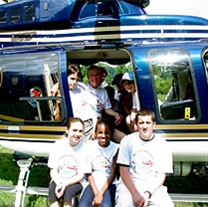Grant Spotlight | May 1, 2006
Share This |
Recipient: |
Project Partner: |
||
Need
To succeed in the 21st century the youth of today need skills in math, science, and technology. The state of New York requires every middle school to have a technology education teacher who helps students see how math and science undergirds modern applications and technologies. A 2004 project in the state paired these technology teachers (and their math and science colleagues) with the lifelong learning resources of public libraries to create a year-long series of presentations that explored math, science, and technology ideas and enabled teens’ imaginations to take flight.
Seven libraries, serving a mix of urban, suburban, and rural areas in six counties, participated in the project that was designed to reach local middle-schoolers—focusing on underserved youth—with learning opportunities and one-of-a-kind experiences.
Goals
The idea for the project was developed at the regional library system level. Mary Fellows, Manager of Youth and Family Services at Upper Hudson Library System, thought that aviation would be a great theme to excite teens and get them interested in learning math, science, and technology. With this grant and other successful programming grants she has obtained for libraries in the system, she hoped to fulfill the public library’s mission as a place for lifelong learning. She said, "Part of our whole premise is that you can learn about anything in the public library. Even if you are not a big reader. If you want to know about planes, we’ve got books, we’ve got videos, and we’ve got DVDs."
Fellows worked with her counterpart at the Mohawk Valley Library System to bundle programming ideas with funding so that member libraries that chose to participate could hire presenters, purchase aviation books and materials, and develop marketing materials to get the word out.
The seven libraries that took advantage of the opportunity were to develop school, library, and summer camp programs in collaboration with their local middle school science and technology teachers. Presentations made at schools were to be tailored by teachers so that they complemented their classroom instruction. Other presentations would be designed to stress real-world applications of science and math in aviation technology and aviation careers.
The technology presented was to go beyond flying machines. The project also was designed to expose teens to information technology through online author chats and database searches at the libraries.
The presentations developed included watching a state police helicopter land, meeting aviation meteorologists, building tissue paper hot-air balloons, and reading about the history of flight. The final treat planned for teens who attended the summer camps was a free plane ride arranged by the libraries through the Empire State Aerosciences Museum in Schenectady.
Strategy
Darlene Miller, Director of the Castleton Public Library in the Village of Castleton, described the resources provided through the project as "phenomenal." The regional library system provided her with a timeline for the grant, a menu of presenters, and $500 for her library and the library of the local Maple Hill Middle School to purchase aviation related materials. In addition the regional library system provided artwork and graphics for Miller to create posters, flyers, and other promotional materials.
In conjunction with Ken Malloy, the Maple Hill middle school technology teacher, Miller developed a schedule of programs for the entire year. She selected some presenters suggested by Fellows and she explored other resources in her immediate area.
Each of the presentations offered a different educational experience and excitement for all involved, not just the kids. For one session, the library arranged to have the group walk down to the Hudson River, where amid a crowd that included the local television crew, they watched a sea plane land and take off. On a different day, the youth were treated to a performance by a re-enactor who portrayed the flamboyant female pioneer aviator Pancho Barnes. During one of the school programs, Malloy walked his students over to a state park, where a state helicopter landed and students could speak with the pilot. In another session, the students interviewed Jeannine Atkins, author of the book Wings and Rockets: The Story of Women in Air and Space, during an online chat. For a number of the children, it was their first introduction to e-mail.
A demonstration of another sort took place after Fellows learned of a nearby company that produced motorized parachutes. The parachutes had been used in a recent James Bond movie, and a company representative came out to the library to demonstrate a part of the technology and talk about working with the film crew.
Teacher Malloy said, "It was an opportunity to see first of all the variety of things that fly and talk about the science of why they fly. What’s more math, science, and technology all rolled into one than putting an airplane together and having it fly."
Results
The seven participating libraries arranged 64 presentations. At the middle school classes, 490 students participated, and at the presentations held at the libraries more than 250 people attended. Fifty-three lucky youth participated in the summer camps.
In surveys following the programs, campers reported that their math, science, and technology skills had improved. In addition to those areas, teachers noticed improvements in information literacy skills.
Students grew in other ways through the program, as well. One girl camper arrived on the day of her scheduled flight saying she was not going to fly because she was too afraid, although her two brothers (they are triplets) were ready. Like many of the children in the program, none of the children had ever flown. The librarian gently encouraged her to reconsider, saying she may regret it later. The girl did decide to go up with her brothers. She returned with a big smile on her face, saying next time she will be less afraid to try something new.
